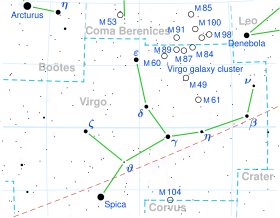Psi Virginis
| Observation data Epoch J2000 Equinox J2000 | |
|---|---|
| Constellation | Virgo |
| Right ascension | 12h 54m 21.16342s[1] |
| Declination | −09° 32′ 20.3783″[1] |
| Apparent magnitude (V) | +4.80[2] |
| Characteristics | |
| Spectral type | M3 IIICa-1[3] |
| U−B color index | +1.57[2] |
| B−V color index | +1.58[2] |
| Astrometry | |
| Radial velocity (Rv) | +12.82[4] km/s |
| Proper motion (μ) | RA: −18.08[1] mas/yr Dec.: −19.52[1] mas/yr |
| Parallax (π) | 5.99 ± 0.23[1] mas |
| Distance | 540 ± 20 ly (167 ± 6 pc) |
| Absolute magnitude (MV) | −1.34[5] |
| Details | |
| Luminosity | 1,448[6] L☉ |
| Temperature | 3,687[6] K |
| Other designations | |
| Database references | |
| SIMBAD | data |
Psi Virginis (ψ Vir, ψ Virginis) is a suspected[4] binary star[3] system in the zodiac constellation of Virgo. It can be seen with the naked eye and has an apparent visual magnitude of +4.80.[2] Based upon the annual parallax shift of 5.99 milliarcseconds, the distance to this star is roughly 540 light years. The angular size of Psi Virginis was measured on December 26, 1975 during an occultation by the Moon, yielding the estimate 6.5±0.3 milliarcsec.[8]
The primary component is an evolved red giant star with a stellar classification of M3 IIICa-1.[3] It is an irregular variable[9] with seven measured pulsation periods ranging from 22.4 to 162.6 days, and amplitudes ranging up to 0.m022.[10] The star is a bright X-ray source with a luminosity of 21.58×1029 ergs s−1.[11] There is a magnitude 8.3 companion at an angular separation of 0.04 arcseconds.[3]
References[]
- ^ a b c d e van Leeuwen, F. (November 2007), "Validation of the new Hipparcos reduction", Astronomy and Astrophysics, 474 (2): 653–664, arXiv:0708.1752, Bibcode:2007A&A...474..653V, doi:10.1051/0004-6361:20078357, S2CID 18759600.
- ^ a b c d Mermilliod, J.-C. (1986), "Compilation of Eggen's UBV data, transformed to UBV (unpublished)", Catalogue of Eggen's UBV Data, SIMBAD, Bibcode:1986EgUBV........0M
- ^ a b c d Eggleton, P. P.; Tokovinin, A. A. (September 2008), "A catalogue of multiplicity among bright stellar systems", Monthly Notices of the Royal Astronomical Society, 389 (2): 869–879, arXiv:0806.2878, Bibcode:2008MNRAS.389..869E, doi:10.1111/j.1365-2966.2008.13596.x, S2CID 14878976.
- ^ a b Famaey, B.; et al. (2009). "Spectroscopic binaries among Hipparcos M giants. I. Data, orbits, and intrinsic variations". Astronomy and Astrophysics. 498 (2): 627–640. arXiv:0901.0934. Bibcode:2009A&A...498..627F. doi:10.1051/0004-6361/200810698. S2CID 18739721.
- ^ Anderson, E.; Francis, Ch. (2012), "XHIP: An extended hipparcos compilation", Astronomy Letters, 38 (5): 331, arXiv:1108.4971, Bibcode:2012AstL...38..331A, doi:10.1134/S1063773712050015, S2CID 119257644.
- ^ a b McDonald, I.; et al. (2012), "Fundamental Parameters and Infrared Excesses of Hipparcos Stars", Monthly Notices of the Royal Astronomical Society, 427 (1): 343–57, arXiv:1208.2037, Bibcode:2012MNRAS.427..343M, doi:10.1111/j.1365-2966.2012.21873.x, S2CID 118665352.
- ^ "psi Vir -- Long-period variable star", SIMBAD Astronomical Database, Centre de Données astronomiques de Strasbourg, retrieved 2016-09-19.
- ^ Evans, D. S.; et al. (October 1977), "Angular diameter of psi Vir (SAO 139033) and chi 1Ori (SAO 077705)", Astronomical Journal, 82: 828–831, Bibcode:1977AJ.....82..828E, doi:10.1086/112134.
- ^ Mennessier, M. O.; et al. (August 2001), "Long period variable stars: galactic populations and infrared luminosity calibrations", Astronomy and Astrophysics, 374 (3): 968–979, arXiv:astro-ph/0105552, Bibcode:2001A&A...374..968M, doi:10.1051/0004-6361:20010764, S2CID 15721872.
- ^ Tabur, V.; Bedding, T. R. (2009), "Long-term photometry and periods for 261 nearby pulsating M giants", Monthly Notices of the Royal Astronomical Society, 400 (4): 1945–61, arXiv:0908.3228, Bibcode:2009MNRAS.400.1945T, doi:10.1111/j.1365-2966.2009.15588.x, S2CID 15358380.
- ^ Makarov, Valeri V. (October 2003), "The 100 Brightest X-Ray Stars within 50 Parsecs of the Sun", The Astronomical Journal, 126 (4): 1996–2008, Bibcode:2003AJ....126.1996M, doi:10.1086/378164.
- Virgo (constellation)
- Slow irregular variables
- M-type giants
- F-type main-sequence stars
- Spectroscopic binaries
- Bayer objects
- Flamsteed objects
- Henry Draper Catalogue objects
- Hipparcos objects
- HR objects
- Durchmusterung objects
